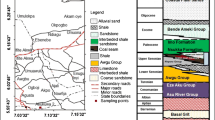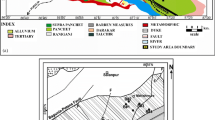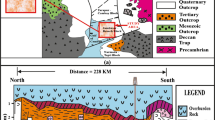Abstract
Shale, an abundant organic-rich sedimentary rock of extremely low porosity, is of lately being realized as a significant energy source, owing to the possibility of huge amount of natural gas which may be stored in it. Instigated by the enormous production of natural gas from the shale formations of Barnett, Marcellus and several other plays in USA, the Indian sedimentary basins are being looked assertively for their shale gas prospects. The petroliferous Cambay basin in western India with interbedded carbonaceous shales in its thick Tertiary sequence forms a potential prospect for the shale gas. Fine grained, clastic and organic-rich Cambay, Tarapur and other Tertiary shales have sourced the oil and gas for the basin.
The quality, quantity and type of organic matter play an important role in the generation of gas in shale horizons. Rock-Eval pyrolysis is one of the most basic organic geochemical methods to study these parameters. In the present study, the interbedded shale formations within the middle Eocene lignite sequences, referred to as Cambay Formation, (Nagori et al., 2013), of the Tadkeshwar and Rajpardi mines in Surat and Bharuch districts, respectively, have been sampled to study the organic matter properties using Rock-Eval pyrolysis. The sedimentary sequences exposed in the mines show the shales to be high in Total Organic Carbon (TOC) content, ranging between 0.2% to 47.3%. The S1 (free hydrocarbons) and S2 (hydrocarbons from cracking of kerogen) values range between 0.04 to 7.12 and 0.08 to 190.11 mg HC/g rock, respectively. The Tmax (temperature at highest yield of S2) varies between 342°C to 450°C, and the hydrogen index (HI) ranges between 32 to 754 mg HC/ g TOC. The variation of HI vs. Tmax suggests an immature to mature stage for the hydrocarbons. The organic matter in shales is characterized by Type II / III kerogen, suitable for the generation of gas.
Similar content being viewed by others
References
Agrawal, C.G. (1986) Structure and tectonics of exposed rocks between Narmada and Kim rivers in South Gujarat. Jour. Geol. Soc. India, v.27, pp.531–542.
Banerjee, A., Pahari, S., Jha, M., Sinha, A.K., Jain A.K., Kumar, N., Thomas, N.J., Misra, K.N. and Chandra, K. (2002) The effective source rocks in the Cambay basin, India. AAPG Bull., v.86, no.3, pp.433–456.
Banerjee, A., Rao, K.L.N. (1993) Geochemical evaluation of part of the Cambay Basin, India. AAPG Bull., v.77(1), pp.29–48.
Behar, F., Beaumont, V. Penteado, H L. and De B. (2001) Rock-Eval 6 Technology: Performances and Developments Oil & Gas Science and Technology — Rev. IFP, v.56 (2), pp.111–134.
Bhandari, L.L. And Choudhary, L.R. (1975) StratigraphicAnalysis of Kadi and Kalol Formations, Cambay Basin, India. AAPG Bull., v.59, pp. 856–871.
Biswas, S.K. (1982) Rift basins in western margin of India and their hydrocarbon prospects with special reference to Kutch basin. AAPG Bull., v. 66, pp.1497–1513.
Biswas, S.K. (1987) Regional tectonic framework, structure, and evolution of the western margin basins of India. Tectonophysics, v.137, pp.307–327.
Boyer, C., Keischnick, J. and Lewis, R.E. (2006) Producing gas form its source. Oil field Rev., v.36, pp.49.
Chandra, P.K. And Chowdhary, L.R. (1969) Stratigraphy of Cambay Basin. Bull. Oil Nat. Gas Comm. v.6(2), pp.37–50.
Chowdhary, L.R. (1975) Reversal of Basement-Block Motions in Cambay Basin, India, and its Importance in Petroleum Exploration. AAPG Bull., v.59(1), pp.85–96.
Chowdhary, L.R. (2004) Petroleum Geology of the Cambay Basin, Gujarat India. Indian Petroleum Publisher, Dehradun, pp.74–111.
Curtis, J.B. (2002) Fractured shale-gas systems. AAPG Bull., v.86, pp.1921–1938.
DGH (2012) Directorate General of Hydrocarbons, India. Retrieved from www.dghindia.org. EIA (2013) United States Energy Information Administartion, Retreived form http://www.eia.gov/energy_in_brief/article/about_shale_gas.cfm
Espitalie, J., Marquis, F. and Sage, L. (1987) Organic geochemistry of the Paris Basin. In: J. Brooks and K. Glennie (Eds.), Petroleum Geology of North West Europe, Graham and Totman, London, pp.71–86.
Hunt, J.M. (1996) Petroleum Geology and Geochemistry,W. H.. Freeman and Company, San Francisco, 617p.
Horsfield, B. and Schulz, H.M. (2012) Marine and Petroleum Geology, v.31 (1), pp.1–136
Jarvie, D.M., Hill, D.J., Ruble, T.E. and Pollastro, R.M. (2007). Unconventional shale-gas systems: The Mississippian Barnett Shale of north-central Texas as one model for thermogenic shale-gas assessment. AAPG Bull., v.91(4),pp.475–499.
Klett, T.R., Schenk, C.J., Wandrey, C.J., Brownfield, M., Charpentier, R.R., Cook, T., Gautier, D.L. and Pollastro, R.M. (2012) Assessment of potential shale gas resources of the Bombay, Cauvery, and Krishna–Godavari Provinces, India, 2011: USGS Fact Sheet 2011–3131.
Krevelen, D.W. (1961) Coal: typology-chemistry-physicsconstitution: Elsevier Science, Amsterdam, 514p.
Kundu, J., Prasad, B. and Prakash, A. (1997) Structural Framework and Distribution of Synrift Depocentres in Cambay Rift Basin, Western India. AAPG Bull., v.81(1), pp.1392–1393.
Lafargue, E., Marquis, F. and Pillot, D. (1988) Rock-Eval 6 Applications. In: Hydrocarbon Exploration, Production, and Soil Contamination Studies, 53, 4, Juillet-Août 1998, IFP.
Mathur, L.P., Rao, K.L.N. and Chaube, A.N. (1968) Tectonic framework of Cambay Basin, India. ONGC Bull,, v.5, pp.7–28.
Milliken, K.L., Rudnicki, M., Awwiller, D.N. and Zhang, T. (2013) Organic matter–hosted pore system, Marcellus Formation (Devonian), Pennsylvania. AAPG Bull., v.97(2) pp. 177–200.
Mccarthy, K., Niemann, M., Palmowski, D., Peters, K. and Stankiewicz, A. (2011) Basic Petroleum Geochemistry for Source Rock Evaluation. In: Oilfield Review, v.23(2) pp.32–43.
Mishra, S. And Patel, B.K. (2011) Gas Shale potential of Cambay Formation, Cambay Basin, India The 2nd South Asian Geoscience Conference and Exhibition, GEOIndia 2011, 12-14th Jan, 2011, Greater Noida, New Delhi, India.
Mohan, M. (1995) Cambay Basin-a promise of oil and gas potential. Jour. Paleonto.Soc. India, v.40, pp.41–47.
Nagori, M.L., Khosla, S.C. and Jakhar, S.R. (2013) Middle Eocene Ostracoda from the Tadkeshwar Lignite Mine, Cambay Basin, Gujarat. Jour. Geol. Soc. India, v.81, pp.514–520.
Peters, K.E. And Cassa, M.R. (1994) Applied Source Rock Geochemistry. In L. B. Magoon, and W. G. Dow, (Eds.) The petroleum system from source to trap. AAPG Memoirs 60, pp.3–120.
Raju, A.T.R., Chaube, A.N. and Choudhary, L.R. (1971). Deccan Trap and geologica framework of Cambay basin. Bull. Volcanol., v.35(3), pp.521–528.
Ross, D.J.K., And Bustin, R.M. (2007) Shale gas potential of the Lower Jurassic Gordondale Member, northeastern British Columbia, Canada. Can. Petrol. Geol. Bull., v.5, pp.51–75.
Ross, D.J.K., And Bustin, R.M. (2008) Characterizing the shale gas resource potential of Devonian–Mississippian strata in the Western Canada sedimentary basin: Application of an integrated formation evaluation AAPG Bull., v.92, pp.187–125.
Rust, Jes., Singh, H., Rana, R.S., Mccann, T., Singh, L., Anderson, K., Sarkar, N., Nascimbene, P.C., Stebner, F., Thomas, J.C., Kraemer, M.S., Williams, C.J., Engel, M.S., Sahni, A. And Grimaldi, D. (2010) Biogeographic and evolutionary implications of a diverse paleobiota in amber from the early Eocene of India. Proc. Nat. Acad. Sci. USA, v.107, no.43, pp.18360–18365.
Sahni, A., Saraswati, P.K., Rana, R.S., Kumar, K., Singh, H., Alimohammadian, H., Sahni, N., Rose, K.D., Singh, L., And Smith, T. (2006) Temporal Constraints and Depositional Palaeoenvironments of the Vastan Lignite Sequence, Gujarat: Analogy for the Cambay Shale Hydrocarbon Source Rock. Indian Jour. Petrol. Geol., v.15(1), pp.1–20.
Singh, P.K. (2012) Petrological and Geochemical Considerations to Predict Oil Potential of Rajpardi and Vastan Lignite Deposits of Gujarat, Western India. Jour. Geol. Soc. India, v.80, pp.759–770.
Singh, A., Thakur, O.P. and Singh, B.D. (2012a). Petrographic and Depositional Characteristics of Tadkeshwar Lignite Deposits (Cambay Basin), Gujarat. Jour. Geol. Soc. India, v.80, pp.329–340.
Singh, P.K., Singh, M.P., Singh, A.K., Naik, A.S., Singh, V.K. and Rajak, V.K. (2012b) Petrological and geochemical investigations of Rajpardi lignite deposit, Gujarat, India. Energy Exploration & Exploitation, v.30(1), pp.131–152.
Tissot, B.P. And Welte, D.H (1978). Petroleum Formation and Occurance. A new approach for oil and gas exploration Springer Verlag, 529p.
Tissot, B.P. And Welte, D.H (1984) Petroleum Formation and Occurrence. 2nd ed. Heidelberg: Springer Verlag, 679p.
USGS (2012) United States Geological Survey. Retrieved from http://pubs.usgs.gov/fs/2011/3131/pdf/fs2011-3131.pdf
van Krevelin, D.W. (1961) Coal: Typology-Chemistry-Physics-Constitution. Amsterdam: Elsevier Science, 514p.
Yalcin, M.N., Welte, D.H., Misra, K.N., Mandal, S. K., Balan, K.C., Mehrotra, K.L., Lohar, B.L., Kumar, S.P. And Misra, H.S. (1987) 3-D computer aided basin modelling of Cambay Basin, India—a case history of hydrocarbon generation. In: R.K. Kumar et al. (Eds.), Petroleum geochemistry and exploration in the Afro-Asian region, Balkema, Rotterdam, pp.417–450.
Author information
Authors and Affiliations
Corresponding author
Rights and permissions
About this article
Cite this article
Mishra, S., Mani, D., Kavitha, S. et al. Pyrolysis results of shales from the South Cambay basin, India: Implications for gas generation potential. J Geol Soc India 85, 647–656 (2015). https://doi.org/10.1007/s12594-015-0262-z
Received:
Accepted:
Published:
Issue Date:
DOI: https://doi.org/10.1007/s12594-015-0262-z




